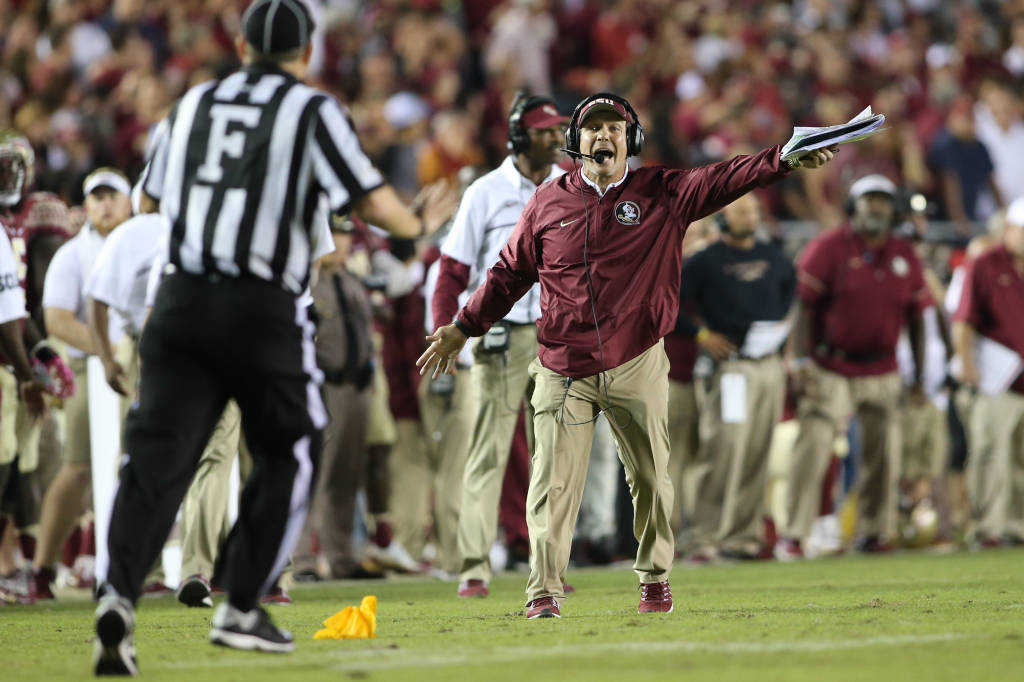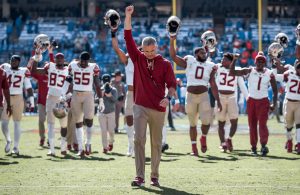- Sunday Seminole Summary: FSU Football Adds Pair of WR Transfers
- Sunday Seminole Summary: FSU Football Exits ESD With Top-15 Class
- Sunday Seminole Summary: FSU Soccer Tops BYU for Third National Championship
- Sunday Seminole Summary: FSU Soccer Advances to National Championship Match
- Seminole Sunday Summary: FSU Soccer Heads Back to College Cup
- Seminole Sunday Summary: FSU Soccer Reaches Sweet 16; Football Tops Boston College
- Seminole Sunday Summary: FSU Soccer Wins ACC, Advances to Second Round of NCAA Tournament; FSU Football Rallies Past Miami
- Seminole Sunday Summary: FSU Soccer Tops Wake on OT to Advance to ACC Final
- Seminole Sunday Summary: FSU Football Crushes UMass for Third Straight Win
- Seminole Sunday Summary: FSU Soccer Stays Perfect with Pair of Wins
Column: Florida State’s Place in College Football’s Arms Race
- By Clint Eiland
- Updated: September 15, 2017
 wlpearce.com/FSU athletics
wlpearce.com/FSU athleticsMaybe it’s just the long break from Florida State football. Maybe it’s just how hectic everything has been with Hurricane Irma. Maybe it’s something entirely different.
But something Jimbo Fisher said during his call-in show on Wednesday night has this writer thinking about the grand picture of college football.
The FSU head coach was asked about which facility he thinks FSU needs the most. His response? It needs its own “football operations” building. Why?
“We’ve got to get caught up…We haven’t done anything for a long time here. We did when we first got here. We made a few little adjustments. Since then we really haven’t.”
Mr. Clark’s column piqued my interest. He gives some very fair considerations, and it’s a piece worth reading when you have the chance. It also got me thinking: what is Florida State’s place in the college football arms race?
Fisher apparently believes that FSU is lagging behind and hasn’t been on top of the situation like it once was. How true is that?
Somewhat true. Florida State football has ascended the rankings when it comes to facilities. For a few years early in his tenure, there was certainly an argument that the Seminoles were not up to speed with their competitors. The addition of an indoor practice facility, a players lounge, movie theatre, a newly-exclusive dining hall, and more changed all that.
Florida State is pretty firmly in line with similar caliber programs. Other sites seem to agree.
There’s also a new Champions Club that operates as an eye-sore whenever TV cameras pan to its direction during games. Reduced seating capacity and luxurious facilities seem to have had quite the opposite effect — no one sits in it during games. The Champions Club will pay for itself down the road, but it does make one question if the administration misjudged its viability. That’s not necessarily in the same group as the other renovations, but it is still indeed a cost related to football.
Fisher’s quote shouldn’t be taken as a huge insult or shot at the administration. He’s simply relaying what he thinks might be a weakness when it comes to competing on the modern college football landscape.
But there’s other factors at play here.
The Academic Progress Rate (APR) is a tool used by the NCAA to maintain a certain academic standard for its member schools. A few teams in the past have actually received punishment for going below the minimum APR score (930). Some factors that go into it:
“Each student-athlete receiving athletically related financial aid earns one point for staying in school and one point for being academically eligible. A team’s total points are divided by points possible and then multiplied by 1,000 to equal the team’s Academic Progress Rate. In addition to a team’s current-year APR, its rolling four-year APR is also used to determine accountability.”
Good news for Florida State fans: athletics as a whole has seen record-high APRÂ rates over the past few years. Four different programs achieved a perfect 1,000 — something never achieved before in school history.
Bad news for Florida State fans: the football team declined for its third straight year. It tumbled from 958 four years ago to 939 last year. That alone isn’t saying much. After all, it could just be bad relative to the other sports teams.
Unfortunately, the larger context says that’s not true. Florida State’s 939 mark is in fact the lowest in the ACC. It’s a full 18 points behind N.C. State. That is by far the largest gap between any two successive schools in the conference rankings.
But the ACC is full of elite colleges: Duke, North Carolina, Virginia, etc. So maybe it’s just the result of the ACC being composed of great institutions?
Well, no. Florida State is actually tied for 124th in the nation. There were 129 teams included. Florida State football had the lowest spot of any Power 5 team, being surpassed by programs like Georgia Southern, Florida International, and Idaho to name a few.
Guess what? That’s embarrassing.
Absolutely no one will deny that college athletics (in general) has an increasingly relevant issue with academic standards. The more money that flows into the system, the more pressure there is to put the best product on the field. That unfortunately means that academic concerns are sometimes brushed aside and ignored.
Let’s be clear: this is not advocating for harsh punishments and ludicrously strict standards. There are plenty of students at Florida State who will never be near the top of the class (one of them is even writing this article!), but are still immensely helped by their time in college. No one should advocate for leaving someone behind all because they don’t do so well in the first few semesters of college.
But is it really so much to ask that Florida State’s football team not be 124th in the nation when the APR numbers come out? The university has made significant progress in recent years at gaining more respectability in the academic sphere.
The recent U.S. News and World report for public universities actually had FSU jump five spots to No. 33 overall. That’s up from a No. 43 ranking just two years ago. Why has the football team lagged behind?
Some might ask about the relevance of bringing this up. Here’s the response:
As college football fans and university students/alumni, we have to ask ourselves if Florida State should hold the team to a fair standard when making these decisions. If any other coach of a Florida State team had publicly complained about the facilities, and it was well-known that the team had a terrible APR, what would the response be? Especially if that program’s facilities were already some of the best in the nation?
So despite three years of declining academic performance and multiple recent innovations, Fisher still wants more. He’s in prime position to receive it too. Athletic director Stan Wilcox has been quoted in the past as saying that the university is looking into it and are certainly considering it. Chances are that Fisher will eventually get the football standalone facility that he wants.
The precedent set by men like Alabama head coach Nick Saban thus continues. Because college football just ain’t what it used to be. It’s a multi-billion dollar business now. You either produce or you’re out.
If Alabama or Clemson or Auburn or Oregon has a standalone football facility, you’ve got to have it too. It doesn’t matter what you possess now, because there’s a school out there that has so much more money than your own, and they’re going to lap you if you’re not careful.
Could this have been avoided by just letting the players profit off their own likeness? Maybe. That’s a whole other conversation, but it’s certainly relevant when looking at the current college football trends.
Instead of just distributing a stipend of some sort, that money is being used to build monuments to wealth. It’s not sustainable, and when the future of college football arrives, we will look back at the current arms race as just delaying the inevitable.
But we don’t live in the future. We live in 2017. In 2017, you’ve got to bulk up with the other heavyweights to remain competitive.
Florida State is willing to do just that. But it’d be nice if there were other considerations too.




You must be logged in to post a comment Login